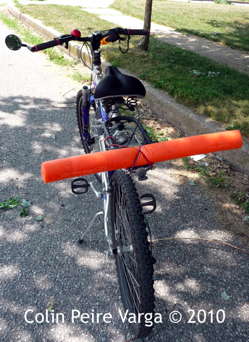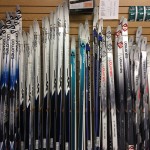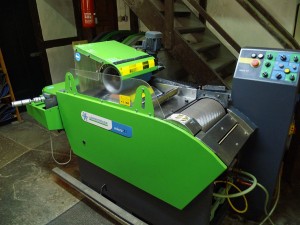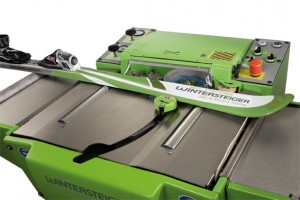Join Shep’s for the much-anticipated summer weekend where we combine chalk art with hot air balloons with rib fest, and sidewalk sales! Come downtown and visit us under the tent for screaming deals on the gear you want – be it summer or winter apparel, ski & snowboard equipment, bikes, wakeboards, waterskis, tubes… (the list could go on); if you’re in town this weekend, you’ll want to be under our tent. Nearly everything in the store is on sale too, so with discounts as crazy as 90% off, it’s worth your trip. (Bring the family too, since you’ll all want to be a part of all that our downtown has to offer this weekend.)
Tag: Wausau
Successful cyclists adopt these smart habits
We like these summaries from our friends at Diamondback bikes and bicyclesafe.com. Keep yourself safe out there and reap the benefits of a two-wheeled commute.
Avoid busy streets.One of the biggest mistakes that people make when they start biking is to take the exact same routes they used when they were driving. It’s usually better to take different streets with fewer and slower cars. Sure, cyclists have a right to the road, but that’s a small consolation when you’re dead. Consider how far you can take this strategy: If you learn your routes well, you’ll find that in many cities you can travel through neighborhoods to get to most places, only crossing the busiest streets rather than traveling on them. Light up.Too obvious? Well, if it’s so obvious, then why do most night-time cyclists ride without lights? Bike shops have rear red blinkies for $15 or less. Headlights are just as important as rear lights. And modern headlights use LED’s so the batteries last ten times longer than old-school headlights.
Take the whole lane when appropriate.It’s often safer to take the whole lane, or at least ride a little bit to the left, rather than hug the right curb. Here’s why:
You might worry about slowing down the traffic behind you if you take the lane. But if you’re on the kind of street where you’ve got cars blocked up behind you or constantly changing lanes to get around you, you’re probably on the wrong street and should find a quieter neighborhood street. Taking the lane works especially well in most roundabouts. The traffic generally moves slower so it’s easy to keep up, riding in the lane makes you more visible to motorists, and taking the lane prevents motorists from right-hooking you as they exit the circle. It’s perfectly legal for you to take the lane when appropriate. Most state laws say you have to ride as far to the right as is “practicable”. Here are some things that make it impracticable to ride to the extreme right:
There are risks to both riding to the extreme right as well as taking the lane. Whether you ride to the right or take the lane depends on the conditions of the roadway you’re on. On wide roadways with few intersections/driveways, right further right. On narrow roads with lots of intersections, ride farther to the left. It’s not always better to take the lane or to hug the curb; it depends on the roadway you’re on. |
Signal your turns.You’re less likely to get hit when your movement doesn’t take motorists by surprise. Let them know you’re about to turn or move left or right by signalling with your arm. Point your left arm out to move left, and point your right arm out to move right. (You might have learned an old way of signaling a right turn with your left arm, but drivers have no idea what that means, so it’s useless. Signal a right turn with your right arm.) Before signaling left, be sure to check your mirror or look behind you before signaling (since a car passing too closely can take your arm out). Re-think music players and mobile phones.It’s more important to hear what’s around you when you’re biking than when you’re driving. Whether you want to ride with headphones is your choice, but doing so does increase your risk. Similarly, texting or talking with a mobile phone raises the risk level. When you’re mixing with car traffic, the fewer distractions the better. Also, you’ll want both hands free in case you have to brake suddenly. Ride as if you were invisible.It’s often helpful to ride in such a way that motorists won’t hit you even if they don’t see you. You’re not trying to be invisible, you’re trying to make it irrelevant whether cars see you or not. If you ride in such a way that a car has to see you to take action to avoid hitting you (e.g., by their slowing down or changing lanes), then that means they will definitely hit you if they don’t see you. But if you stay out of their way, then you won’t get hit even if they didn’t notice you were there. On very fast roads cars have less time to see you because they’re approaching so fast. Of course, you should avoid fast roads in the first place if at all possible, unless there’s plenty of room for a car and a bike side by side. And if there IS such room, then on fast roadways, you can practice invisibility by riding to the extreme right. If you’re far enough right that you’re not in the part of the lane the cars are in, then they’ll zoom by and won’t hit you, even if they never saw you. Here’s another example: It’s a good idea to signal a left turn, but it’s a better idea to make your left turn at a time or place where there aren’t cars behind you that could hit you while you’re stopped and waiting to make that turn. You can hang out in the middle of the street, stopped, with your left arm out, waiting to make your turn, but you’re counting on cars behind you to see you and stop. If they don’t see you, you’re in trouble. Naturally we don’t advocate running red lights, but if you’re the kind of person who does, then apply the invisibility principle when deciding on whether to run a particular light: Could any cross traffic possibly hit me if I were invisible? If yes, then absolutely don’t do it. Never make a car have to slow down to avoid hitting you (red light or not). Remember, the more you rely on cars to see you to avoid hitting you, the more chances they’ll have to actually do so. Remember, you’re not trying to BE invisible, you’re just riding with the assumption that cars can’t see you. Of course, you certainly want them to see you, and you should help them with that. That’s why you’ll wave to motorists whom you think might be about to pull out in front of you, and why you’ll be lit up like a Christmas tree at night (front and rear lights). Remember that in many cases you’ll need to take the lane, in which case you’re counting on motorists to see you. |

Pedaling along country roads warrants a specific set of safety considerations. As you roam rural lanes, keep the following in mind.
Don’t expect motorists to see you. In city traffic, dense streets and attentive drivers mean the key to safety is being assertive and using the rhythm of traffic to your advantage. But as your bicycle carries you away from town, the safer place to be becomes the side of the road. Likewise, plan to dodge cars in intersections even when you have the right-of-way.
Look behind you. Glance over your shoulder as you approach every driveway, intersection, and road hazard. Yes, every single one. A common car-on-bike incident is the right hook. This is when a car passes a cyclist, slows to turn right, and obliviously crosses the cyclist’s path on the edge of the street.
Watch for oncoming traffic. Passing motorists often accelerate into the opposite lane without looking for cyclists in their path. Similarly, I shudder to think about how frequently I make fast right turns onto two-lane roads without considering what might be might be fast approaching on the wrong side.
Avoid riding into the sunset. Riding into the sun makes you virtually invisible to motorists. If you’re stuck heading west at the end of the day, try taking a meandering route. And when the sun’s at your back, keep in mind that road users ahead will have difficult time seeing you.
Pause in high-visibility places. Whether you’re changing clothes, fixing a flat, or answering the call of nature, wait until you’re a safe distance from blind corners or hillcrests.
Don’t antagonize motorists. Sure, they might pass to closely, or worse. But on isolated roads, it’s best stay calm and let the incident roll off your back. It’s the only way to stay safe, have fun, and protect our image as cyclists.
Hundies Matter! Shepherd & Schaller is Wisconsin Ski Racing HQ
Calling All Ski Racers!
Wausau is Wisconsin’s Ski Destination, and Shepherd & Schaller is headquarters to Alpine and Cross Country Racers alike. Are you part of a team? Interested in trying something new? Have your eye set on a Gold Medal? Come see us. Racing equipment and maintenance is highly specialized and regulated. You’ll want expert help and with 65 years experience, Shepherd & Schaller is where the experts shop, tune and wax their skis.
We partner with Granite Peak Ski Team and support Wausau Nordic Ski Club skiers, offering team members special pricing on race equipment. We also contribute significantly to their ski swaps and support their fundraising activities year-round. Visit or call for contact info and details! 715-845-5432.
Good stuff happening above the Dungeon at Shepherd & Schaller Oct. 22-26
You’ve just found the perfect ski boots for the little one, new skis and poles for dad, and mom is excited about her new ski package at Shepherd & Schaller’s famous Dungeon Sale, October 22-26, 2014. You know the one – it’s the sale where you’ll find scary-good prices on new and used ski and snowboard equipment for the whole family!
It’s time to head upstairs for great deals on Outerwear, Sportswear, Footwear and Accessories for ski season! We can’t name our famous names, because the deals are too good to advertise. But, here’s what you’ll find for five amazing ski-sale days:
- Buy 3 Get 1 Free: Smartwool Socks (20% off a single pair if you prefer)
- 20% off all in-stock Outerwear for adults and kids. (Kids from size 2T through 16/XL). Includes Jackets, Pants, Fleece, Mittens & Gloves, Hats and Balaclavas. Base Layers too.
- 20% off all in-stock Sportswear. Sweaters, Pants, Leggings, Tops, Shirts, Skirts, Dresses, Hoodies, T-Shirts. All of it.
- 20% off all in-stock Footwear. Running Shoes, Winter Boots and outdoor Fashion Footwear.
- 20% off in-stock necessities including: Handbags, Backpacks, Water Bottles and Home Decor
- 20% off in-stock Helmets and Goggles
- 20% off in-stock tuning tools and wax
- Ski Binding Adjustments and Remounts for ski equipment purchased in the Dungeon Sale = $10
- Complete 10-step Ski Tune, including hot wax $34.99 (Reg. $55)
- 50% off select in-season shoes and boots
- Sale prices on all of our new 2014/15 Ski and Snowboard Equipment. Save even more when you bundle your purchase to include skis, boots, bindings, poles or board, boot and binding.
- 50% off remaining 2013/14 outerwear for adults and kids
- Demon Phantom Audio Helmet $49.99 (Reg. $69)
- Giro Bevel Helmet $39.99 (Reg $65)
- Scott Little People Goggle $11.99 (Reg $19)
- Scott Classic Goggle $19.99 (Reg $42)
- Scott Strike Goggle $29.99 (Reg $75)
- Scott Heli OTG Goggle $29.99 (Reg $65)
What’s not included you ask? Only a few items we are restricted from discounting like Yakima, and some year-round things like kayaks, camping accessories and bike accessories. (We do have sale “Shep’s” prices on remaining water sports, bicycles and some camping gear.)
Announcing BIG changes in our tune shop!
The tuning shop at Shep’s has always delivered outstanding quality and service when it comes to prepping your gear for the best possible performance on the hill. This year, we’re making it even better. LOADS better!
Every winter, we strive to bring you the best performing, hottest new skis, boards, and gear on the planet, and people are hitting the slopes now more than ever. Our tuning wizard, Pete Kohlmoos, works his magic tuning, waxing, edging and repairing. To meet our own increasing demands while staying true to our promise of providing our customers with the best possible service and quality, we’ve purchased four new pieces of tuning equipment from Wintersteiger.
Known for their legendary quality and results, Wintersteiger produces industry leading tuning equipment that can be found worldwide tuning skis for the highest caliber of skiers. Shep’s expects nothing less for our customers. We want our racers on the best gear available, tuned to the highest standards. We want the fastest possible turnaround time to get skiers of all levels back on the slopes, and we strive to deliver cutting edge services that simply can’t be found anywhere else in our area. To do this, here’s what we updated:
Micro 71 Stone Grinder: An update to our existing machine, the Micro 71 is capable of tuning skis and snowboards of all widths with exceptional results. Need the bases on those powder skis fixed up? No problem! Board a bit rough after hours in the park? We’ll get it looking great!
Trim 71 Ceramic Disc Edger: With a specific machine for sharpening base and side edges of skis and boards, Shep’s is now able to bring you laser accurate performance.
Waxjet 93: Designed to deliver hot wax to skis and snowboards in a faster and more efficient manner, the Waxjet 93 provides a deeper penetrating wax to your equipment while using less materials. This translates to a better performing product while leaving a smaller footprint on the environment. It will also significantly speed up our tuning time, getting your equipment done and back to you in record time!
 Drivetronic: By far, this is the machine we are the most thrilled to introduce to our customers! The Drivetronic is an alpine ski binding tester designed to do one thing: ensure each and every binding that leaves our shop is performing properly and in the safest manner possible. We want you to be safe and have equipment that is performing at its best. The Drivetronic, combined with our highly-trained ski technician, will allow us to do just that.
Drivetronic: By far, this is the machine we are the most thrilled to introduce to our customers! The Drivetronic is an alpine ski binding tester designed to do one thing: ensure each and every binding that leaves our shop is performing properly and in the safest manner possible. We want you to be safe and have equipment that is performing at its best. The Drivetronic, combined with our highly-trained ski technician, will allow us to do just that.

































